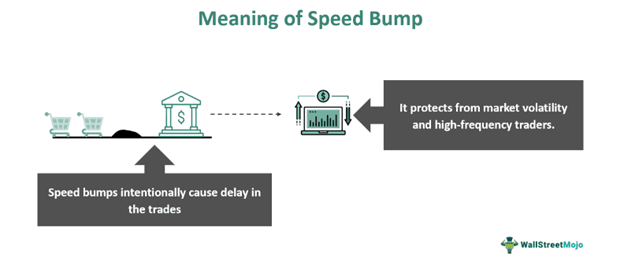Table of Contents
Speed Bump Meaning
Speed bump in trading refers to the intentional delay during the execution of trade orders on the exchange. It acts as a tool to introduce latency (slowdown) in the orders placed by traders. The primary purpose is to prevent high-frequency traders from exploiting market-moving information.

Speed bumps can be of various forms. However, the only difference lies in the time taken to delay execution. In addition, there can be random bumps also. They aim not to let traders predict the outcome of the slowdown. As a result, better price stability is maintained in the markets.
Key Takeaways
- Speed bumps refer to the delay caused by the orders executed with the motive of preventing high-frequency traders from exploiting the market.
- Such bumps are employed by trading platforms or exchanges that favor the interests of the market participants. It results in better price discovery and stability in the market.
- The two major types of bumps include symmetric and asymmetric bumps. While the former has a constant delay of milliseconds, the latter diffuses an uneven delay depending on various factors.
- As orders travel the coil and reach the exchange matching machine, the delay ensures that all market data is reflected accurately.
Stock Exchange Speed Bump Explained
Speed bump is a financial term used to describe an intentional delay caused in the trades. It reduces the order execution by a few milliseconds. As a result, the chances of exploitation by high-frequency traders decrease as they cannot place a large number of orders instantly. Thus, any order placed on the exchange will face a latency, which further stabilizes the volatility in the market. In addition, high-frequency traders (HFT) do not receive a chance further to exploit the system's algorithms for their sole benefit.
In most cases, trading exchanges have used speed bumps for latency purposes. However, the origin of the concept dates back to 2013. At that time, ParFX, a bank-backed platform, introduced random bumps to curtail the benefits of HFT. The delay was around 20 to 80 milliseconds. Similarly, in the same year, even the EBS platform employed a similar tactic with a randomized algorithm with a delay of one to three milliseconds. However, the popularity of these bumps occurred with the introduction of the IEX exchange in 2016. They brought in a massive speed bump of 350 microseconds to execute. Since then, many exchanges have incorporated this tool into their algorithms.
The mechanism of these bumps works on a simple technology of network latency. Some coils cause time delays up to a certain limit. For instance, the speed bump exchange, IEX, contains a coil of 38 miles with a latency of 350 microseconds. So, before arriving, the distance of the coil results in a delay. During this period, the exchange can take in market data and update prices.
Many traders use Saxo Bank International to research and invest in stocks across different markets. Its features like SAXO Stocks offer access to a wide range of global equities for investors.
Types
The speed bump can cause delays in two ways: symmetric and asymmetric. And each holds a different meaning. Let us understand them in detail:
#1 - Symmetric Bumps
Symmetric bumps create a similar pattern on both sides of the plane. All market participants experience the same minimum delay in the orders executed. There is no partiality or bias created in these bumps. As a result, the delay occurred uniformly across all traders. For example, the American IEX speed bump exchange has implemented such delays.
#2 - Asymmetric Bumps
In contrast, asymmetric delays are those random speed bumps that follow no uniformity in delays. It does impose delay as per the order type. They utilize certain tools and mechanisms through which the frequency of trading is reduced. The delay may change depending on the market condition, order size, or trade type. Some of the applications include Euronext, Eurex, and ICE in Europe and the United States, respectively.
Examples
Let us look at some hypothetical and real-time examples to understand the concept better:
Example #1
Suppose Samuel is a trader who operates in the equity and commodity market. In the past few years, he has gained massive wealth of around $12000 as profit. However, in the last week, Samuel was not able to benefit from the price fluctuations. He was operating on the TVX exchange, which installed speed bumps. The sole purpose of having them was to reduce the frequency of HFT. And the exchange was successful in doing so.
After a week of installation, the executed trades had to travel a coil of 25 miles before reaching the exchange matching engine. At this time, these bumps reduce the order speed and make them wait in a queue. Once the exchange is successful in reflecting the market data, they can enter the exchange. As a result, Samuel's trades were now free from volatility spikes.
Example #2
According to a news update as of December 2023, the popular latency platform TMX Group has introduced a new trading platform with two order books (Alpha-X and Alpha DRK). The purpose of this exchange is to stay aligned with the parent group to cause delays in trade execution.
Likewise, the deliberate involvement of speed bumps will hold active orders for almost three milliseconds without impacting other traders. Besides, it also holds a smart limit order, including 300 parameters across all markets in Canada.
Benefits
These bumps offer various advantages to traders and exchanges. Let us understand them in brief:
#1 - Better order execution
One of the prime advantages of speed bumps is visible in the trade orders executed. It reduces the risk of adverse selection (having knowledge unknown to others), which high-frequency traders often take. As a result, the trades executed face no exposure from such HFT.
#2 - Enhances the market stability
These bumps also help in developing a balance between the demand and supply forces. They reduce the intensity of market movements, which are mostly triggered by HFT strategies.
#3 - Reduces volatility and sudden price spikes
Likewise, with stability, the exchange also witnesses low volatility spikes in the market. It smooths the highs and lows in the orders entering the matching machine and does not let it influence the ongoing market prices.
#4 - Improved fairness
Due to a consistent delay among trading platforms, HFT traders cannot exploit the trading algorithms for their benefit. It creates a uniform, stable delay for all trades irrespective of order type and size to reduce its impact on overall market forces.
#5 - Better price discovery
Furthermore, such massive speed bumps refrain HFTs from instantly acting on market information. Thus, the rest of the market traders can discover better prices reflecting accurate data.
Disclosure: This article contains affiliate links. If you sign up through these links, we may earn a small commission at no extra cost to you.

